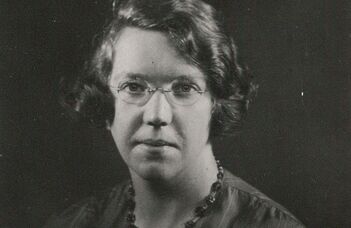
It's good that she’s being remembered. Jane Haining was a Scottish missionary who came from a rural part of Dumfriesshire and served as matron of the Girls’ Home at the Scottish Mission to the Jews in Budapest from where she was taken to Auschwitz with her Jewish charges to die at the age of 47. I’m interested in her story because my branch of the Council of Christians and Jews was so taken by a talk on her life that we have set up a project, not just to promote her life but to use it as a reflection on racism, antisemitism and islamophobia in today’s society. Last week four of our group travelled to Dunscore where Jane was born to meet with a group of parishioners from the parish church who have set up a visitors’ centre and developed a trail around the area to educate visitors about the only Scot to have died in Auschwitz and named Righteous Among the Nations at Yad Vashem in Jerusalem, Israel’s memorial to victims of the Holocaust. We were welcomed warmly and seeing the farm where Jane was born, the primary school she attended, the Church she walked to each Sunday, her name on the Dux table at Dumfries Secondary School where she boarded, brought her to life.
Jane is well known in the Church of Scotland and probably even better known in Budapest where she worked. Every year there is an essay competition on her life and work and the winners come to Scotland to visit the Central Offices of the Church, the village of Dunscore and Queens Park Church of Scotland in Glasgow where she worshipped before going to Hungary. There is a street next to the Danube in Budapest named after her, Jane Haining Rakpart, and just last year the village of Loanhead in Midlothian named a street ‘Haining Park’ in her memory. Our project hopes to extend this essay competition or something akin to it to Scottish schools. We also have plans for a Jane Haining trail in and around Glasgow but one that will include the Jewish community and highlight some aspects of their history and how this relates to Jane’s life. It will also involve looking at challenging questions. It was after all the Church of Scotland’s Mission to the Jews that ran the school in Budapest – what did that mean then, has the Christian understanding of mission and missionary changed, how is it now understood?
Jane refused to abandon the Jewish girls in her care after the Nazi invasion of Hungary. She was on holiday at home when the Second World War broke out and returned to be with her charges. With the German invasion of Hungary, the political situation worsened, and she refused to heed requests by the Church of Scotland to return to the safety of Scotland, saying ‘If these children need me in days of sunshine, how much more do they need me in days of darkness?’. She was in tears as she sowed the yellow star on to the clothes of the Jewish pupils. Dr Ninon Leader, a pupil at the school and Goddaughter of Jane, talking a few years ago at a Holocaust Memorial event in Glasgow, recalls the day when it was made compulsory for anyone Jewish to wear what was meant to be a badge of shame and how Jane “sobbed and walked with red eyes among us”. She also told of how “acting in Miss Haining’s spirit and personality, irrespective of their religion, every single boarder in the Mission Home sewed a yellow star on their uniforms”.
We Scots can be proud of Jane Haining. We can see in her life the tragic consequences of prejudice, discrimination, and hatred. At a time when racism and antisemitism have not disappeared from our country hers is an example we want to emulate. As members of the Council of Christians and Jews we want to encourage understanding and respect, a recognition of our common humanity, our common citizenship not just of our country but of the world. We have rooted our project in the value of loving kindness/chesed. This for us is the foundation for our conviction that we belong to one human family; for our appreciation, reverence and respect for diversity and the uniqueness of each human being and our determination to work to overcome discrimination and to further understanding, acceptance, and kindness between cultures. This we believe is a step towards ensuring peaceful co-existence and stability in our world today. Surely there is no better legacy for Jane Haining than this.?



 RSS Feed
RSS Feed
